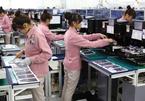in the development of science and technology, said economists and policymakers.
 |
| A wind farm in southern Bac Lieu Province. — VNA Photo |
Dr Bui Quang Tuan, head of the Vietnam Institute of Economics, said only with scientific and technological innovations can the country create new economic drivers, to improve productivity and to add more value to its products, elements that are keys to maintaining rapid GDP growth.
In recent years, the country has seen a shift from an agriculture-based to an industrialised economy with the growth of its processing and manufacturing industries. The Vietnamese workforce also saw one of the fastest productivity growth rates in the region. The country's labour productivity for 2019 was US$4,790, a 6.2-per-cent increase from the previous year.
Vietnam, however, still trailed behind other ASEAN economies at 45.6 per cent of Indonesia, 56.9 per cent of the Philippines, 19.5 per cent of Malaysia and just 7.6 per cent of Singapore.
"Science and technology is our only hope in raising labour productivity," Tuan said.
Hong Sun, vice-president of the Korea Chamber of Business in Vietnam, said there are certain similarities between Vietnam today and South Korea in the 70s. The South Korean government was among some of the first to invest in and encourage the development of science and technology.
"The keys to rapid growth lie in science and technology," he said.
At the same time, the country must invest in strategic areas such as education, infrastructure and development policies, said economist Pham Chi Lan. She insisted those are key to unlocking the country's potential for scientific and technological advancement.
Middle-income trap
Vietnam's income per-capita in 2019 was $2,800 or $3,000 if the informal economy was included, according to the General Statistics Office of Vietnam, effectively putting the country in the low-middle income group.
In order to become a high-income country by the year 2045, the country must meet its target of $12,000 income per-capita, Lan said. In other words, Vietnam would need to quadruple its current GDP in just a quarter of a century, a goal as ambitious as it is challenging.
As the size of the economy grows, it will become increasingly difficult to maintain a high growth rate, said Lan. While it was feasible to achieve annual 7-8 per cent GDP growth in the 2000s when Vietnam's economy was relatively small it will require a tremendous amount of effort to stay on that course as the country's GDP nearing the $200 billion mark.
In addition, Vietnam must build a resilient economic model, especially in the context of a globalised world, and support the development of the private sector. VNS

How to keep the sun always shining?
Vietnam is setting specific economic timelines and targets with a desire to become a high-income country - something not many countries can do. How should that aspiration be energized?

Vietnam needs to new growth model to escape middle-income trap
Building a reasonable growth scenario and finding out ways to achieve the goal is how that Vietnam can escape the middle-income trap.